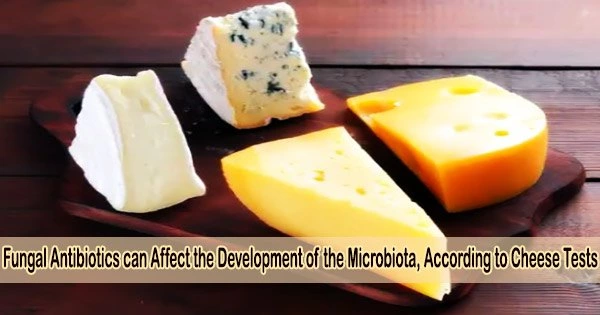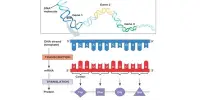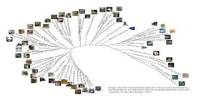Humans have employed metabolites produced by fungi to enhance health. They release penicillin, for instance, which is then refined and utilized as an antibiotic by humans, inspiring the creation of numerous other antibiotics.
However, little is known about the ecology of fungal metabolites in microbial communities. In a recent study, scientists used cheese rinds to show that fungal drugs can affect the evolution of microbiomes. The study is published in mBio.
“My lab is interested in how fungi shape the diversity of microbial communities where they live. Fungi are widespread in many microbial ecosystems, from soils to our own bodies, but we know much less about their diversity and roles in microbiomes compared to more widely studied bacteria,” said principal investigator of the new study Benjamin Wolfe, Ph.D., associate professor in the Department of Biology at Tufts University.
His research group focuses on the relationships between fungal and bacterial species in microbial ecosystems.
“To study the ecology of fungi and their interactions with bacteria, we use cheese rinds as a model microbial ecosystem to understand these basic biology questions,” said Wolfe.
Cheese rinds are microbial communities that form on the surfaces of naturally aged cheeses such as Brie, Taleggio and some Cheddars. Communities of bacteria grow on the surfaces of these cheeses while the cheese ages, leaving behind fuzzy and occasionally sticky layers. The cheese curd progressively decomposes as they develop on the surface, producing scents and colors that give each handmade cheese its distinct characteristics.
Several years ago, a cheesemaker reached out to Wolfe with a mold problem: A mold was becoming abundant on the surfaces of the cheesemaker’s cheeses and was disrupting the normal development of their rind. As the mold spread throughout their cheese cave, it seemed as though the rinds were gone. Wolfe and his colleagues had the ideal opportunity to examine the ecology, genetics, and chemistry of fungal-bacterial interactions because of the mold invasion.
Our results suggest that some pesky mold species in artisan cheeses may disrupt normal cheese development by deploying antibiotics. These findings allow us to work with cheesemakers to identify which molds are the bad ones and how to manage them in their cheese caves. It also helps us appreciate that every time we eat artisan cheese, we are consuming the metabolites that microbes use to compete and cooperate in communities.
Professor Benjamin Wolfe
In an effort to learn more about how this mold was affecting the microbial population on the rind, Wolfe’s team started working with Nancy Keller’s lab at the University of Wisconsin. They were interested in learning what the rind bacteria were subjected to by the mold and what compounds the mold might be releasing that might affect the rind.
In order to conduct their investigation, the scientists first altered the expression of a gene (laeA) known to regulate the release of compounds that fungi can exude into their environment in the Penicillium mold. These compounds are called specialized or secondary metabolites.
“We know that many fungi can produce metabolites that are antibiotics because we have used these as drugs for humans, but we know surprisingly little about how fungal antibiotics work in nature,” said Dr. Wolfe.
“Do fungi actually use these compounds to kill other microbes? How do these antibiotics produced by fungi affect the development of bacterial communities? We added our normal and our laeA-deleted Penicillium to a community of cheese rind bacteria to see whether deleting laeA caused changes in how the community of bacteria developed.”
The majority of the Penicillium mold’s antibacterial activity was gone, the researchers discovered, when laeA was eliminated. The ability to focus on particular areas of the fungal genome that may be creating the antibacterial chemicals as a result was thrilling for the researchers. Finally, they were able to focus on a group of substances known as pseurotins.
These are metabolites made by a variety of fungus that have been proven to have intriguing biological properties include modifying the immune system, eradicating insects, and inhibiting the growth of bacteria.
The work is the first to demonstrate that pseurotins can regulate the growth and development of bacterial communities that coexist with those fungi. The pseurotins produced by the Penicillium mold in cheese are strongly antibacterial and dramatically inhibited certain bacteria compared to others (the bacteria inhibited were Staphylococcus, Brevibacterium, Brachybacterium, and Psychrobacter, which are found on many artisanal cheeses). This caused a dramatic shift in the composition of the cheese rind microbiome in the presence of the Penicillium-produced pseurotins.
This study shows that the development of microbiomes can be influenced by antibiotics released by fungi. The researchers predict that these processes of fungal-bacterial interactions are common because many fungus create comparable compounds in a variety of diverse environments, from the human microbiome to soil ecosystems.
“Our results suggest that some pesky mold species in artisan cheeses may disrupt normal cheese development by deploying antibiotics,” said Wolfe. “These findings allow us to work with cheesemakers to identify which molds are the bad ones and how to manage them in their cheese caves. It also helps us appreciate that every time we eat artisan cheese, we are consuming the metabolites that microbes use to compete and cooperate in communities.”
















